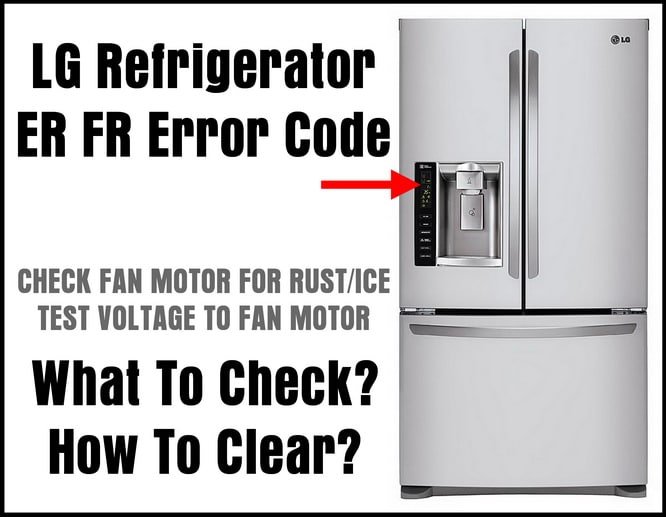
Error codes can seem like a foreign language, but they’re essentially your refrigerator’s way of communicating that something’s not quite right. Think of it as a virtual SOS call from your fridge. The E3 error code specifically usually signals a problem with the defrost cycle. Simply put, your refrigerator is struggling to keep things chilly because it can’t properly manage the frost buildup. But, just like any simple maintenance task you do around the house, fixing this doesn’t necessarily mean you need an engineering degree.
Understanding the E3 Error Code
So, what exactly does the E3 error code entail? Well, in the world of LG refrigerators, the E3 error is primarily associated with a defrosting issue. Remember how an ice-cube-filled freezer can stop the door from closing properly? That’s kinda what’s happening here, only inside the coils or the evaporator fan. The fridge isn’t working at its best because of frost buildup, which can lead to everything from spoiled food to sky-high electric bills.
In more technical terms, this code often points to a malfunction in the defrost sensor circuit. The refrigerator relies on sensors to monitor the frost levels. If something’s off with these sensors, it might not initiate the defrost cycle as it should. It’s like trying to play a game of tag without knowing the rules—frustrating, right? An unchecked defrost issue can lead to severe accumulations of ice, potentially affecting other components like the evaporator fan motor. Fortunately, most of the time, these issues are manageable without needing to call a technician.
To add some context, the defrost cycle is critical for maintaining efficiency. It’s what stops your fridge from turning into a winter wonderland. When frost starts taking over, it creates insulation, making it harder for your fridge to do its job. Imagine wearing a snowsuit in summer—yep, it’s that kinda struggle for your fridge.
How to Diagnose an E3 Error Code
Alright, let’s roll up our sleeves and get into diagnosing an E3 error code. First off, safety first! Always unplug your refrigerator before poking around. Now, you’re going to want to locate the defrost sensor. It’s usually hanging around somewhere near the evaporator coils. This sensor is a small component but a mighty one, much like the temperature gauge in your car.
Once you’ve found it, you’ll need to check if it’s working correctly. How, you ask? Using a multimeter—this handy tool measures electrical resistance and can tell you if the sensor is functioning properly. If the multimeter doesn’t show any reading, that’s a red flag indicating the sensor may be faulty.
While you’re in there, take a look at the defrost heater as well. The heater’s job is, well, to provide heat to keep frost at bay. If it’s not heating up, the frost won’t melt, leading to the very problem you’re facing. A failed heater can often be identified by visible damage like burnt spots or breaks.
Troubleshooting and Fixing the E3 Error Code
Let’s say you’ve diagnosed the problem—great! But what next? If it turns out the defrost sensor or heater is kaput, these parts can usually be replaced without too much hassle. It’s like swapping out a faulty light bulb; once you have the right replacement, it’s plug-and-play. Your local appliance store or online marketplace can be your go-to for the right parts. Just ensure you have the refrigerator model number handy.
If you’re a bit hesitant about tackling the fix yourself, there’s no shame in calling a professional technician. They deal with these issues day in and day out and can often get things sorted quickly. It’s sometimes worth the peace of mind knowing it’s been handled thoroughly and correctly.
For those who are DIY-inclined, make sure to follow any installation instructions that come with the replacement parts. You don’t want to inadvertently cause more harm than good. Once everything’s replaced, plug your fridge back in and keep an eye on it for the next 24 hours. If the error doesn’t return, you’ve likely fixed the issue.
Preventative Measures and Final Thoughts
Nobody wants to deal with pesky error codes, so let’s chat about ways to avoid them in the future. Regular maintenance is key. Like a car needs oil changes, your fridge needs some love too. Ensure you’re not overstuffing it, as blocked air vents can lead to improper cooling and frost buildup. It’s like trying to stuff too many clothes into a suitcase—things can’t move properly, and it just leads to problems.
Another tip is to periodically check the door seals. If air is leaking, your fridge works overtime to compensate, leading to—you guessed it—more frost. A simple way to check this is using the dollar bill test: close the door on a bill. If it pulls out easily, you might need to replace the seals.
In conclusion, while seeing an E3 error might initially be unnerving, understanding what it means and how to address it can save you both time and money. With the right know-how, a little patience, and maybe some professional help, you can keep your fridge running smoothly for years to come. Remember, appliances are like teammates in your home’s ecosystem—keep them in check, and they’ll serve you well.
